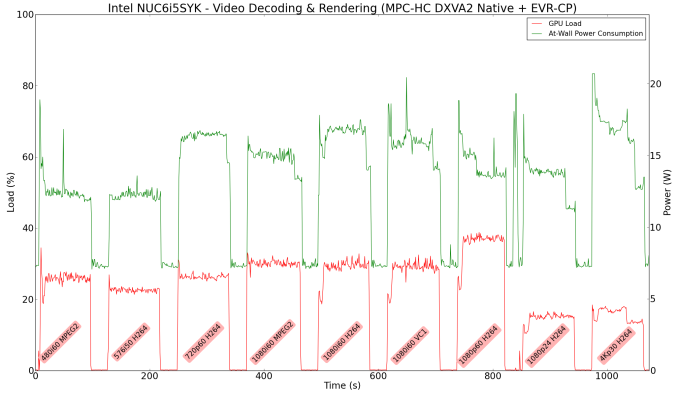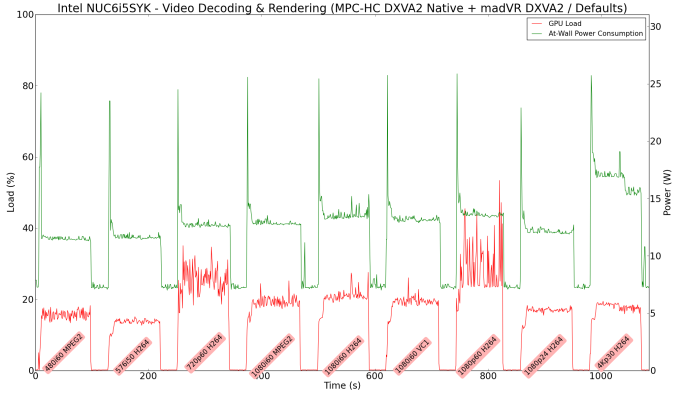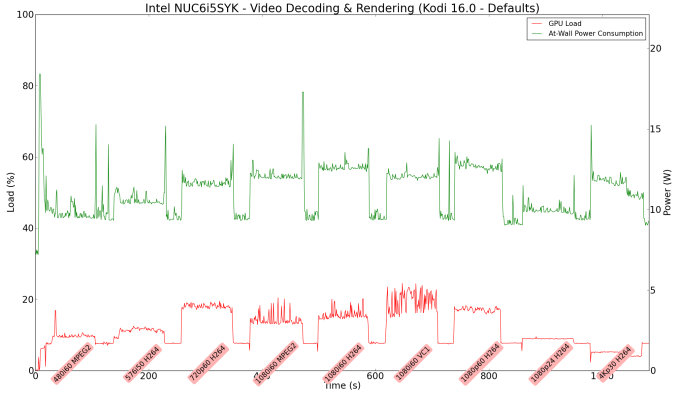The Intel NUC6i5SYK Skylake UCFF PC Review
by Ganesh T S on March 11, 2016 8:00 AM ESTHTPC Credentials
The thermal solution on the NUC6i5SYK is the same as what we have seen in the previous NUCs. Since the Core i5-6260U is a 15W TDP processor, the acoustics are pretty decent (when compared to the fans on the units with 28W TDP processors). Subjectively speaking, the unit is silent for most common HTPC use-cases. Only under heavy CPU / GPU loading (such as stressful madVR configurations) does the fan become audible. Like the previous NUCs, the NUC6i5SYK retains CIR support, enabling use of IR remotes in a home theater setting. The unit definitely makes a good HTPC for folks who don't want to pay the premium for a passively cooled system - however, we didn't find too many improvements over the previous NUCs for HTPC workloads. There is still no HDMI 2.0 / HDCP 2.2 / 4Kp60 HDMI support in the unit.
Refresh Rate Accuracy
Starting with Haswell, Intel, AMD and NVIDIA have been on par with respect to display refresh rate accuracy. The most important refresh rate for videophiles is obviously 23.976 Hz (the 23 Hz setting). As expected, the Intel NUC6i5SYK has no trouble with refreshing the display appropriately in this setting. In fact, the NUC6i5SYK has the most accurate display refresh rates of all the PCs that we have evaluated so far.
The gallery below presents some of the other refresh rates that we tested out. The first statistic in madVR's OSD indicates the display refresh rate.
Network Streaming Efficiency
Evaluation of OTT playback efficiency was done by playing back our standard YouTube test stream and five minutes from our standard Netflix test title. Using HTML5, the YouTube stream plays back a 1080p encoding. Since YouTube now defaults to HTML5 for video playback, we have stopped evaluating Adobe Flash acceleration. Note that only NVIDIA exposes GPU and VPU loads separately. Both Intel and AMD bundle the decoder load along with the GPU load. The following two graphs show the power consumption at the wall for playback of the HTML5 stream in Mozilla Firefox (v 44.0.2).

GPU load was around 24.27% for the YouTube HTML5 stream and barely measurable for the steady state 6 Mbps Netflix streaming case. Note that GPU usage reported by GPU-Z doesn't actually measure the load on the dedicated decoder engines in the GPU.
Netflix streaming evaluation was done using the Windows 10 Netflix app. Manual stream selection is available (Ctrl-Alt-Shift-S) and debug information / statistics can also be viewed (Ctrl-Alt-Shift-D). Statistics collected for the YouTube streaming experiment were also collected here.

Decoding and Rendering Benchmarks
In order to evaluate local file playback, we concentrate on EVR-CP, madVR and Kodi 16.0. We already know that EVR works quite well even with the Intel IGP for our test streams. Under madVR, we used the DXVA2 scaling logic wherever available, and left the rest at default (as it is well known that the stressful configurations don't work even on the Iris Pro-equipped processors). We used the DXVA2 native decoder in the LAV Filters bundled with MPC-HC v1.7.10
In our earlier reviews, we focused on presenting the GPU loading and power consumption at the wall in a table (with problematic streams in bold). Starting with the Broadwell NUC review, we decided to represent the GPU load and power consumption in a graph with dual Y-axes. Nine different test streams of 90 seconds each were played back with a gap of 30 seconds between each of them. The characteristics of each stream are annotated at the bottom of the graph. Note that the GPU usage is graphed in red and needs to be considered against the left axis, while the at-wall power consumption is graphed in green and needs to be considered against the right axis.
Frame drops are evident whenever the GPU load consistently stays above the 85 - 90% mark. The NUC6i5SYK has absolutely no trouble with any of our test streams. Kodi is the most power efficient of the lot, while madVR with DXVA scaling is actually quite power efficient and comparable to EVR-CP.
Moving on to the codec support, the Intel Iris Graphics 540 is a known quantity with respect to the scope of supported hardware accelerated codecs. DXVA Checker serves as a confirmation. Recent driver updates have added VP9 decode support, but, only for 8b encodes.





















95 Comments
View All Comments
ganeshts - Friday, March 11, 2016 - link
Hmm.. I haven't seen anyone use 'til now'.But, 'till date' is definitely common where I grew up / learned English: http://english.stackexchange.com/questions/146767/... ; It might not be the best thing to use in other parts of the world, but it is not wrong.
kmo12345 - Saturday, March 12, 2016 - link
I noticed this as well.I also disagree with your statement that it is not wrong. I don't doubt that it has entered common usage in Indian English but I have never heard or seen this phrase in the UK, North America, or even Latin America. So while it may be correct in Indian English it is incorrect in any other forms of English.
nivedita - Sunday, March 13, 2016 - link
The dictionary disagrees with you.http://www.oxforddictionaries.com/us/definition/en...
gietrzy - Friday, March 11, 2016 - link
Can you please point me to Intel white papers pdf where they say m.2 in Skylake can do more than 1600 MB/s?Tia.
ganeshts - Friday, March 11, 2016 - link
Sunrise Point-LP has PCIe 3.0 lanes, and the M.2 slot uses four of them. All I can say is that, with the appropriate M.2 SSD, you can utilize four PCIe 3.0 lanes' bandwidth.jdogi74 - Saturday, March 12, 2016 - link
Sorry, but you sound like a politician. Isn't there some contact at Intel that can provide some reasoning and confirmation for this limit or has Anandtech lost all of it's industry clout?jdogi74 - Saturday, March 12, 2016 - link
I completely agree. It's a shame that this review did not address this issue. Really, it's the only thing I came to this review hoping to learn. I have seen reports from users indicating that the M.2 on these is, for some reason, capped at 1600MB/s.This review states... "full support for PCIe 3.0 x4 M.2 SSDs"... yet there's obviously some other factor that prevents these units from getting the most out of it. Given that, I would expect a review on this site to cover it and at least investigate and explain this limitation so that the readers get a better understanding of when PCIe 3.0 x4 really is PCIe 3.0 x4 and when it's not.
Can anyone explain why this alleged PCIe 3.0 x4 essentially perfoms as if it were PCIE 2.0 x4 or PCIe 3.0 x2.
Really.
jdogi74 - Saturday, March 12, 2016 - link
Sorry, I should also mention that Intel's own specs on these also confirm this 1600MB/s limit. So we know it's there. I just want to understand how it's PCIe 3.0 x4 but then it isn't.ganeshts - Sunday, March 13, 2016 - link
I benchmarked both the SM951 and 950 PRO NVMe SSDs, and the best-case bandwidth (large sequential reads) is around 1710 MBps for both.I have asked my Intel contact for the reason behind this, and I will either update things in this comments thread, or have a separate pipeline piece (depending on the depth of Intel's reply).
TheinsanegamerN - Friday, March 11, 2016 - link
Does this NUC have the ability to up te TDP, like haswell iris NUCs could (going from 15 to 28 watt, allowing both higher boost clocks and longer periods of sustained clock speeds.)?And has intel said anything about the skull canyon NUC, with the GT4e GPU?